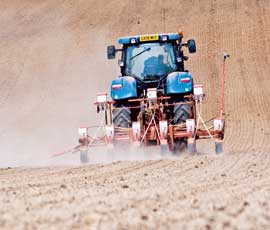Spring OSR most profitable crop on Devon farm

A last-minute switch from spring oats to spring oilseed rape last year proved to be a good move for farm manager Peter Watts.
Not only did the crop achieve a good yield of 3t/ha, it was also cheap and easy to grow, fitting in well with the farm’s three-year rotation and environmental scheme obligations.
“We have an HLS agreement in place on the contract farm in question,” explains Mr Watts. “That means the land isn’t available for drilling until early April.”
His normal procedure is to grow spring oats in that position, which have always performed well, he adds. “But they don’t tend to break any records. The oilseed rape prices were so good when we were considering the options, that it was difficult to ignore them.”
Some quick calculations confirmed his suspicions, so the approach was changed for 2011. “The farm hasn’t grown much oilseed rape before, so there were no agronomic concerns about altering the rotation. Winter oilseed rape isn’t an option on that farm, because of the HLS scheme.”
At this stage, he is intending to repeat the experience in 2012. “However, oats could be worth more next year and the straw does have a value, which is very relevant in this area as there’s a strong demand for it.
“New crop prices are very difficult to predict, but the oilseed rape crop yielded so well and was so straightforward to manage and market, that we will take some convincing.”
The farm’s usual three year rotation is spring oats, winter wheat and spring barley, which has to work with the existing HLS agreement. “We wait for the land to be released in April, as it comes out of barley stubbles, before we drill the spring break crop.”
This year, some 35ha of spring oilseed rape were drilled in the first week of April. The variety was Senova’s conventional type Tamarin, which with a gross output of 104%, was the highest yielding variety on the Recommended List at the time.
“The crop was drilled by 6 April, which was fortunate, because it rained heavily that weekend,” recalls Mr Watts.
The result was a rapid, even germination. “It grew away quickly, so it got the best possible start. It was very dry before then, so the moisture arrived at just the right time.”
Attention to producing the best possible seed-bed also paid off. “I am fussy about seed-beds and with crop prices where they were, it made sense to spend some time and money on seed-bed quality. And the seed had a flea beetle treatment on it, to prevent early feeding damage.”
Half of the crop’s total nitrogen requirement of 130kg/ha was added to the seed-bed, with the remainder being applied a few weeks later. Both phosphate and potash were also added to the seed-bed.
“Otherwise, it received a cheap and cheerful application of 1.25 litres/ha of Sultan (metazachlor), for both grass and broad-leaved weeds. There was no need for any fungicide or insecticide, as pollen beetle didn’t make an appearance. So the growing costs were minimal.”
The yield of 3t/ha was very pleasing, admits Mr Watts. “Past experience had told us to expect 2t/ha. So the final result was good, especially as the crop sold for £380/t. The oil content was very high, so there were bonuses too.”
However, it was the last crop to be harvested, he acknowledges. “It was combined on 7 and 8 September, so it was getting late. It was direct cut, as Tamarin is a fairly short variety, and there was no need to use glyphosate first.”
Whether spring oilseed rape stands the test of time at Lyneham Estate remains to be seen, he says. “Certainly it was the best crop on that farm last year. But it was a good year for most crops in this part of the country, as we escaped the worst of the drought.”
Mr Watts recognises the risks associated with spring drilled crops. “But we have a very mild climate in South Hams, usually with plenty of rainfall. Spring crops aren’t nearly as risky here as they are in the drier eastern areas.”
New hybrid
DSV’s new hybrid, Makro, joined the HGCA Descriptive List in November 2011, with the highest gross output of 109%.
The variety also topped the list for seed yield (107%) and its high oil content (44.5%) helps improve growers chances of achieving an oil premium. According to DSV, it is medium flowering (5 rating) and later maturing, allowing growers to spread their harvest load. It is a relatively tall variety and although it has very good stem characteristics, it may benefit from the use of a PGR.
Margin calculator
See the Digital edition of Crops for a free, interactive spring cropping margins calculator. Type in your own prices and costs, or use the default figures from John Nix, and see how the different options compare for your business

